
by Jeff Andrews, Northern Tails Sharpening
Ultrasonic Cleaners (UC) have been used in the grooming industry for years. I used to mix chemicals in beakers when I was an R&D chemist for GP years ago, and it did very well. The UC works like a microwave oven using ultrahigh frequency tones to move molecules of water or liquid in a container.
The best use of the UC for blade care is cleaning blade plaque between the blade teeth. The plaque is breeding grounds for viruses and bacteria, and you cannot completely kill them with over-the-counter disinfectants alone.
Blade plaque consists of media from pet dander, hair and organic soap film. It is a perfect media for culturing bacteria and viruses. The UC does a wonderful job to this end.
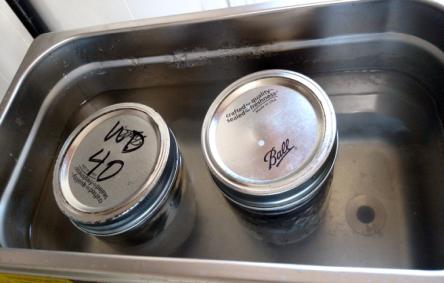
SET UP
I prefer plain water in the UC bath. Why? There are two reasons. First, I like doing several cleaning operations at one time. I use several different cleaners placed in mason jars. You cannot do that if your bath holds only one cleaner. I use one cleaner for rust, another one with WD-40 and a third one using a degreasing cleaner. I get the latter at Lowes for $12.00 a gallon. Second, when I remove the jars from the bath, drips are plain water and chemicals.
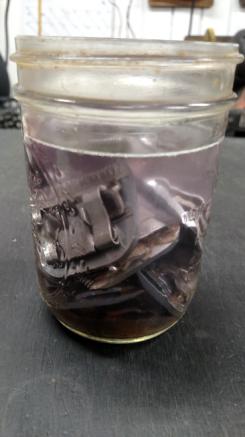
CLEANING
My way is pretty unique compared to others, but I based my method on years of experience finding the best way. When using mason jars the cleaning waves of the UC go right through glass. Careful, do not use plastic jars. The waves act differently. Arrange blades in the mason jars any way you want. I suggest you get as many as you can inside.
Fill the jar with cleaning solution to a level higher than the blades. The water level of the bath must be at the same level as the liquid in the jar or higher.
Run the UC for 10 minutes unless otherwise instructed. Do not heat the bath because the UC will heat the liquid inside the jar. Do not seal the jars tight. Leave a little crack allowing the liquid inside to expand a little as needed.
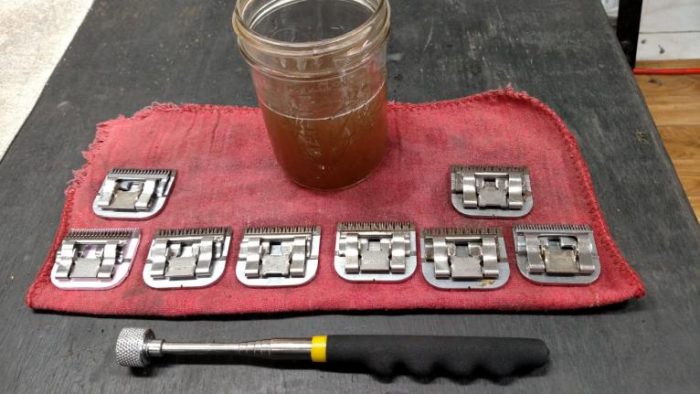
POST CLEANING CYCLE
After the cleaning cycle reach in the bath and pull out your jar(s). Some UC units can fit three mason jars. The jars are likely to drip from the bath but you do not have to worry. It should just be nonhazardous water. Had you treated the bath with a solution like WD-40, you would have to wear gloves when you remove the blades one at a time, and related risks to breathing fumes. There is no reason to risk your safety.
Take your jar(s) of clean blades to a table, or remove them from the jar(s) right at your UC location. I suggest using a magnet to remove blades and then laying them on a towel. You can put a stick on your magnet for this purpose. It is also a handy way to put blades into jars as well without making splashes. You can purchase magnet extension arms at Harbor Freight, Home Depot, Lowes or similar stores.
Get the bulk of the moisture off the blades by hand drying on the towel.
Next, use your air hose, force dryer, or hair dryer and blow the remaining liquid off the blade. Be sure to completely dry between the teeth as well as under the spring in order to prevent any rust.
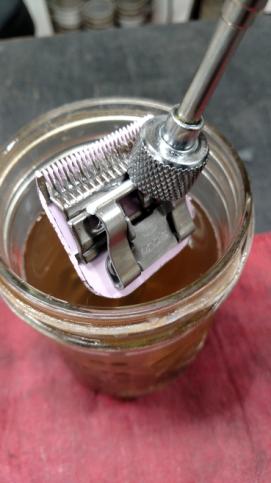
SECONDS
If you find remaining blade plaque repeat the entire procedure. Blade plaque may be difficult to remove the first time and have not regularly cleaned your blades. If you begin regular cleaning with your UC a few times a week you should successfully avoid blade plaque buildup.
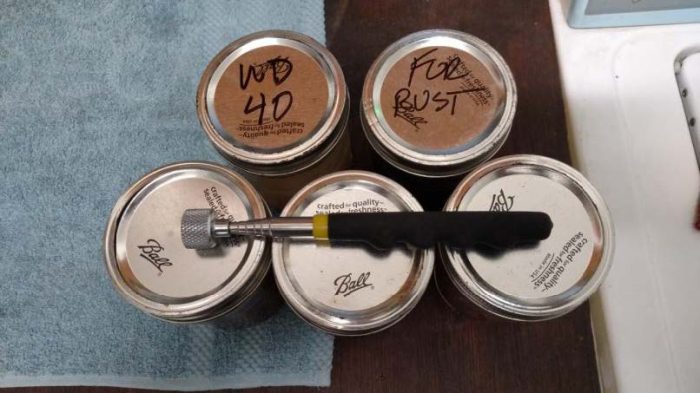
COMPLETE KIT
Here is the complete kit I use to clean blades. I have one jar with straight WD-40. It breaks away chunks of blade plaque from between the teeth when a soap solution alone is insufficient. I have another jar with WD-40 Rust Dissolver. We use it when blades have rusty spots not removed by our radial wheel cleaning. I keep three jars with a soap solution. I mix 1 part soap (Krud-Kutter, Simple Green, etc) to 3 parts water. The more water in the mix the better for cleaning.
Your cleaning solution will look dirty even after the first use, but I have found the used solution works well for several treatments. Dirt falls to the bottom of the jar. When the dirt builds up to ¼ inch deep replace the solution.

FINISHED PRODUCT
In the picture you see cleaned blades from one jar. We removed them from the jar using magnet shown. The cleaning jar solution looks dirty but it can be used a few more times. You can decide if you want to reuse or not. Once hand-wiped and blown completely dry, apply oil to the cleaned blades.


